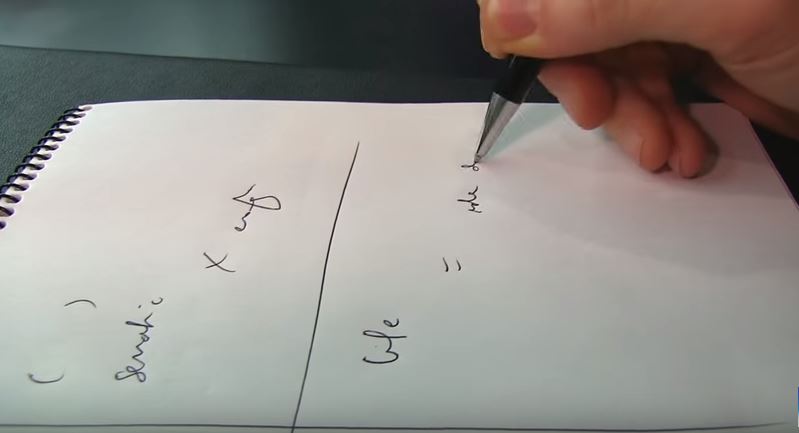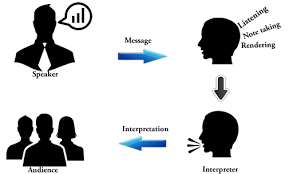consecutive interpretation
Aperçu des sections
-
Consecutive Interpretation
- Definition
- Examples
- Requirements
- Techniques
- Task

-

Consecutive interpretation
It is a form of verbal communication. It takes place when a person speaks in a given language, and is followed by the interpreter’s conversion of what was said . During these sessions, there are pauses or breaks between sentences when each party is speaking. In other words, the interpreter listens then interprets.
-
Here is an example of a consecutive. Watch the video and Pay attention to what the interpreter does.
-
Consecutive interpreting is also required in courts, here is an example of court consecutive interpretation.
-
-
Who can perform CI?
This kind of interpreting requires special skills and training. A translator without consecutive training will perform poorly.
-
Telephone interpretation services connect a live human interpreter via phone. During these appointments, interpretation is consecutive which means the interpreter waits until the speaker is finished to convert what was said from one language to another.
When is Phone Interpreting Preferred?
1.) Over-the-phone services are ideal when a professional in-person interpreter is not available. It eliminates the risk of miscommunication and liability concerns should an inaccurate interpretation take place. For example, while family members, bilingual co-workers, or social workers may speak the required language, they do not necessarily have the same credentials and training that a professional interpreter holds. A language services company really is the only way receive precise interpretation.
2.) Depending on the circumstance, cultural norms, or religious background, an individual may prefer to not have another person present in the room. Health conditions or legal issues can make one feel self conscious, embarrassed or exposed. In these situations, the patient or client’s preference to be anonymous is taken into consideration.
3.)When the telephone is the primary means of communication, it makes sense to use telephone interpreters versus in-person or video interpreters. For example, most of us have heard an automated message like, “For Spanish, please press two.” When this option is pressed, the caller is directed to a phone interpreter. These services are common for customer service, medical help lines and other service phone numbers, making the familiarity of the phone interpretation experience a factor when choosing language services.
-
As we know, interpreters are expected to have much more than just language skills. Besides having thorough knowledge of the target language (usually the foreign working languages), interpreters should also master their own language and culture, as well as the cultures of the foreign languages with which they work. There are also other significant aspects in interpreting: ethical and professional principles; the role of the interpreter as a communication agent and as the liaison between languages and cultures.
In consecutive interpreting, and for the most experienced interpreters, note-taking is, to a large extent, small in importance when compared with the constant efforts to analyse what is being said, understand its meaning and render it into speech in simultaneous interpreting. However, for the less experienced interpreters, note-taking is a tough hurdle to overcome. It is to the latter that this article is addressed.THE PITFALLS OF NOTE-TAKING
The note-taking process is not entirely perfect. It can never replace the oral presentation we have heard earlier. Nonetheless, much of what we say is of little importance for the purpose of the conversation. The role of the interpreter in this note-taking process is, therefore, to select what is being said and to render only what will matter to the message recipients.
- This cannot be a mechanical process: the more mechanical the interpreter’s notes, the lower the quality of the interpretation.
- Taking notes is not the same as taking dictation; it’s meant to jog the memory of the interpreter when he/she has to render the interpretation.
- Notes are short-lived and can only be used within minutes after the speech to be interpreted is delivered. When the speaker finishes the speech, it is still fresh in the memory of the interpreter and the notes are there to jog his/her memory.
- Notes are personal; this is why they can only be used by the interpreter who jotted them down and only for a specific period of time.
- The problem with too many notes is that we might pay too little attention to the speaker’s words. Rendition may, therefore, end up being a superficial speech with serious mistakes and easily avoidable contradictions.
-
ADVICE ON NOTE-TAKING
Here is a list of measures suggested by professional interpreters:
- Take notes quickly – above all, don’t wait for the “right” word because this is not the time to do this;
- Jot down words that are easy to understand in order to jog your memory when you have to render the speech;Avoid using loose pages or you’ll end up with disorganised sheets of paper; instead, use 15 x 20 cm notepads;Write only on one side of the page;
- Use a pencil;
- Jot down readable notes so that when you’re stressed about rendering the speech you won’t waste time searching for the ideas;
- During rendition, always maintain eye contact with the audience;
- Use a large letter size that can easily be read from afar;
- Avoid using ambiguous abbreviations – for example, “ind” should not mean “independently” in some cases and “industrial” in others;
- Use existing symbols and never invent a symbol during the speech that is not easily recognizable;
- Change the structure of the notes using your good judgement, always respecting the cohesion of the speech and the speaker’s intention.
WHAT YOU SHOULD JOT DOWN
Always take notes of:
- The main ideas: secondary ideas will be remembered during the mental interpreting process and rendition;
- Opinions and points of view: they are always perceptible and the interpret might not be able to transpose them to his/her interpretation during rendition;
- Numbers: they are very important for the speech, are the same in every language and are easy and quick to note down (as opposed to dates that are more difficult to understand);
- Proper names: because you don’t have to translate them. For proper names difficult to understand, the interpreter should jot them down as they sound. Also take note of geographical names, names of companies and organisations, abbreviations and acronyms.
- Technical terms: they are less frequent and may sound uncanny to the interpreter;
- Mnemonics: memory aids to help the interpreter jog his/her memory during rendition;
- Connectors: they connect the memory and what the speaker has said. They are important because they show the sequencing of ideas and also opposing ideas;
- What happened and when (verb tenses): because they situate the speech in time;
- The sentences said by the speaker that serve as introduction and conclusion, as they help to understand the speech;
- Keywords: they are important not for their linguistic meaning, rather for what they mean in the interpreter’s mind (the meaning they acquire for the speaker).
HOW TO TAKE NOTES
It all depends on the purpose of the speech to be interpreted: an informative speech requires full note-taking, especially when it is about particularly unusual facts; however, if the event is unusual, one word may be enough. A descriptive speech also needs full note-taking, but based on detailed aspects that perfectly describe what is meant to be conveyed. An argumentative speech is based on much less information, especially connectors and some keywords.
Notes should preferably be taken in the language into which the interpretation will be made (target language), because it allows the interpreter to dissociate the two languages. The interpreter will, therefore, be less likely to use a literal translation in the heat of the speech.
If the interpreter doesn’t remember a word in the target language when taking notes – and to avoid being stuck on that word and getting lost in the speaker’s speech – he/she should note down the term in the source language and continue to take notes. This will save lots of time until the right word comes to his/her mind.
Some interpreters have developed a perfect system of symbols to help them later on. Abbreviations, on the other hand, can be very useful when we’re dealing with names of countries (DE for Germany, PTfor Portugal), units of measurement (km for kilometre or m for meter) or chemical elements (O for oxygen, Pu for plutonium), among others.
http://www.atanet.org/chronicle-online/wp-content/uploads/3710_24_hana_laurenzo.pdf
-
Based on the aforementioned tips, try to take notes of the following video
